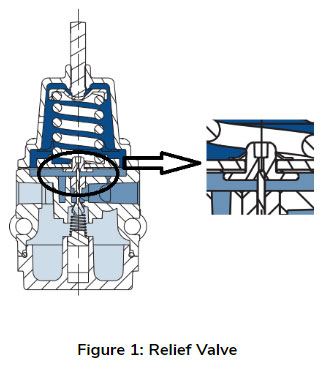
What is the difference between a relieving and non-relieving regulator?
Visually from the outside, there is usually no difference between a relieving and non-relieving regulator. Functionally there is a major difference. A relieving regulator can bleed pressure from downstream if the pressure rises above the setpoint, even in a no-flow condition. Normally this is done by a relief valve (or hole) in the center of the diaphragm and the pintle assembly. A large majority of pressure regulator applications use a relieving regulator.
You can see the small hole that the pintle closes against when the downstream pressure is at or below the set point. If downstream pressure builds, the diaphragm, with attached relief seat, will lift off of the pintle and let pressure escape into the atmosphere. Here are some reasons why downstream pressure would build:
- Mechanical forces acting on a cylinder
- Changes in temperature of a downstream system
- Filling of liquid in a vessel for a tank blanketing application
The non-relieving regulator does not have the relief hole in the diaphragm assembly. These types of regulators are normally used in steady flow applications, which rely on this constant flow to eliminate the possibility that downstream pressure will build past the regulator set point. When using a non-relieving regulator, we would always recommend having some type of downstream pressure relief capability to protect process, equipment and life. Some reasons to use a non-relieving regulator would be:
- Constant flow application with some downstream relief already in place
- To eliminate the possibility of relief exhaust through the regulator which would prevent hazardous or expensive air or gas from escaping from the regulator.
We do not recommend non-relieving regulators for non-flowing or "dead ended" applications without other means to relieve downstream pressure. Without a relief valve the tendency in this case is for the downstream pressure to increase to supply pressure.
Most ControlAir regulators have a non-relieving option. If you are unsure which type to use, please feel free to contact our support team by email, phone or our chat feature on our website.

